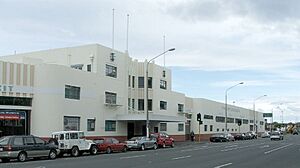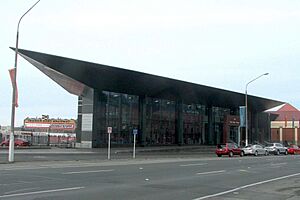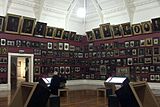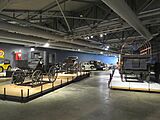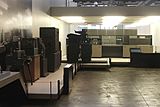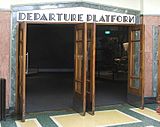Toitū Otago Settlers Museum facts for kids
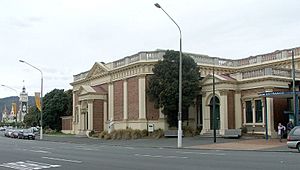
Toitū Otago Settlers Museum main wing (Dunedin Railway Station is visible in the background)
|
|
| Established | 1898 |
|---|---|
| Location | 31 Queens Gardens, Dunedin, New Zealand |
The Toitū Otago Settlers Museum is a cool place in Dunedin, New Zealand. It tells the story of the Otago region, from the Waitaki River south. This museum focuses a lot on the city of Dunedin itself. It's actually the oldest history museum in New Zealand!
Contents
History of the Museum
How the Museum Started
The museum began in 1898. This was 50 years after Scottish people first settled in Otago. It was started by the Otago Early Settlers' Association. By 1908, the museum moved into a special building in Queen's Gardens, Dunedin. At first, it only focused on the very first European settlers. These were people who arrived between 1848 and the first Otago gold rushes in 1861. Over time, the museum started including stories of people who arrived later. That's when the word 'early' was removed from its name. The museum's collections grew to show these changes. They still focus on history since James Cook first visited southern New Zealand in 1770.
Growing and Facing Challenges
In 1927, the museum took over the building next door. This building used to be the Dunedin Public Art Gallery. The museum sometimes had money problems and didn't get much help from the city council. Other similar museums in Auckland and Wellington even closed after World War II. People weren't very interested in New Zealand's history back then. The time from 1949 to 1977 was a tough period for the museum. It had large buildings and many different collections. These included furniture, clothes, old technology like appliances and vehicles, plus old papers and artworks. Keeping everything in good shape and even heating the buildings was a big challenge.
A New Beginning for the Museum
In 1978, a new director named Seddon Bennington started a plan to make the museum better. Another director, Elizabeth Hinds, continued this work. The Dunedin City Council began giving more money to the museum. In 1991, the council took over owning and running the museum completely. They bought the old New Zealand Railways Road Services bus station next door. This building, built in 1939, is a great example of Art Deco style. It's now used to show old vehicles and machines. It's connected to the old museum by a walkway built in 1994.
In 2006, the city council decided to add big new parts to the museum. This was to bring all the collections together in one place. It also helped store and show them better. There were plans for an observation tower, but that idea was later dropped. On April 4, 2008, a broken water pipe caused some flooding. It cost $45,000 to fix, but luckily, no museum items were permanently damaged.
Famous Locomotives at the Museum
The museum has a very popular steam locomotive called Josephine. It's an E class Fairlie locomotive from 1872. It's the oldest preserved steam train in New Zealand! When it was saved in the late 1920s, it was the first train ever preserved in the country. The museum also has the newest preserved steam locomotive in New Zealand, JA 1274. This train started working in December 1956. It was the last steam train built by the New Zealand Railways Department in Dunedin. It was also the last new steam train built for the national rail network. It stopped working in 1971 and moved to the museum a few years later.
The museum also has many paintings. These include works by Dunedin's surveyor Charles Kettle and artist Alfred Henry O'Keeffe. There are also many paintings by George O'Brien. The museum has a research center and a huge collection of photos of early European settlers.
What You Can See Today
The museum had big renovations in 2011 and 2012. It reopened in December 2012 with a new name: Toitū Otago Settlers Museum. The name "Toitū" was suggested by a local family. It means "to remain unchanged" and represents the water, land, and sky of this area. It was also the name of a stream that used to run near where the museum stands now.
The improvements include a new building attached to the northern end. This new part has the main entrance, a gift shop, and a cafe. It also houses Josephine and is called the Josephine Foyer. Another new building north of the museum holds the JA 1274 locomotive.
Exploring the Stories of Otago
The updated museum now tells the story of Dunedin and its surrounding areas in order, from oldest to newest. It starts with the first meetings between southern Māori and Europeans in the late 1700s, right up to today. The exhibits have cool interactive computer screens. The two older parts of the museum show history from before Europeans arrived, through the Otago gold rush, and up to the end of the 1800s. You can see costumes, detailed scenes (dioramas), and multimedia displays.
The popular Smith Gallery, also called the Portrait Room, is still there. Its walls are covered with paintings and photos of the city's early settlers. A new computer screen in the middle of the room lets you find out more about the people in the pictures.
Transport, Technology, and More
The old connection between this area and the former bus depot is now a research center. It also has a military history display with a Roll of Honour. This remembers all the people from Dunedin who died in wars. It's fittingly close to the Dunedin Cenotaph, a war memorial outside the museum.
The former bus depot now shows items from the 1900s. There's a transport hall with historic vehicles, from old wagons to a trolley bus. There's also a section about digital technology. This includes some of the city's first computer equipment, like a huge ICT 1301 mainframe computer. This is one of only four like it in the world! Another part shows Dunedin's creative history, including its early radio and television industries. You can also learn about the famous Dunedin sound music scene. The old bus depot's Art Deco entrance hall has been kept just as it was.
- The interior of the revamped Toitū Otago Settlers Museum
-
The former bus depot's Art Deco waiting room has been restored to its original condition.
Chinese Garden
A beautiful traditional Chinese garden was built right behind the museum's southern wing. It opened to the public on July 8, 2008. This garden is special because there are very few like it outside of China. Part of the garden was a gift from Dunedin's sister city, Shanghai. It was designed with help from landscape experts from Shanghai.


